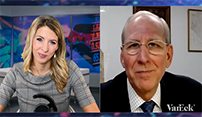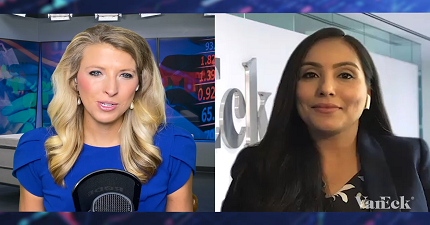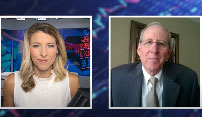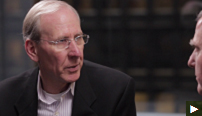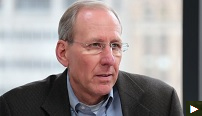Still Shining Bright: Golden Anniversary for VanEck’s Gold Strategy
20 February 2018
Watch Time 6:29
2018 Marks Golden Anniversary for International Investor Gold Fund
GILLIAN KEMMERER: Welcome to the broadcast. I’m Gillian Kemmerer. VanEck has long been associated with gold Investing and its history and growth are paved in it. 2018 marks the 50th anniversary of VanEck's active gold strategy, and I'm joined today by CEO, Jan van Eck, who'll walk us through the firm’s history as it relates to gold and the prescience that shaped the firm. Jan, thanks for joining us and congratulations on the anniversary.
JAN VAN ECK: Thank you.
KEMMERER: Let’s start with the origins of this gold fund. Obviously they date back to your father, so tell us a little bit about the opportunity he identified.
VAN ECK: I think there are two things: there is the narrative of what happened at the time and then, larger lessons for investing. Let’s talk first about the narrative. My father started the firm VanEck in 1955, originally to invest in international stocks in Europe and Japan after World War II. In his 40s (he married late and had little kids), even though he barely had enough money to cover the household expenses, he decided to get a PhD in economics at night. (Because people have so much free time after they have a couple of small kids at home, right?) He started studying at NYU under an Austrian economist named Ludwig von Mises, who was, basically, a hardcore monetarist. That’s the way I’d describe him. He really believed that credit cycles are what drive the world economy. After studying this, the way I describe it is, my father “drank the Kool-Aid” sold 80% of his stocks and put it into gold mining shares. The interesting thing about gold at the time was that it was fixed at $35 an ounce. If you know anything about modern finance theory that's based on risk, which is measured by volatility, they blow up if the volatility of an asset is zero. It was really an out of consensus, odd thing to do at the time. It basically said that, even though inflation hadn't been a problem in the United States for a long time, it was really going to be a problem in the near-term future, and that's why he offered that strategy.
Consequently, we broke off of the gold standard and gold went from $35 an ounce to $800 an ounce, and gold shares were spectacular. That fund was actually the best performing fund in the industry and it put my dad on the map. But more interesting to me is: What are the investment lessons learned? This really goes to what VanEck as a firm stands for, which is: Think out of the box! For example, what is going on? Don't just look at your Bloomberg and at what's happening in the financial markets, think rather: Are there trends over here? Political trends, economic trends, historical trends that are about to affect the financial markets, either for opportunity or for risk? That has been our overall approach. It explains international stocks and it explains gold. We got into emerging markets and ETFs. And even now we're looking at digital assets and bitcoin. I say that gold was kind of the Bitcoin of his time! When my dad started the gold fund, I’m sure people thought he was nuts. I think that's a useful analogy both ways, just as most people think that bitcoin's kind of crazy.
KEMMERER: But it is something that you've been willing to touch and talk about, which is very different from a lot of your competitors, which really reflects the story that your father told.
VAN ECK: I think the key is to identify asset classes before everyone knows they're an asset class. That is where you get the returns and the real diversifications. International stocks weren't really an asset class in the 1950s. And emerging markets, when people started the first emerging markets funds, they weren’t a Morningstar category. It is like digital assets today. The key is not to just chase fads. That's a tough qualitative judgment to make. We don't want to chase fads. We want to start strategies that really makes sense in portfolios.
KEMMERER: Obviously gold is not a fad, but the industry has changed significantly from when your father was first investing in it. Has the investment process necessarily changed with it?
VAN ECK: You had this moment where there's a great opportunity, let's say gold before in the 1970s, but the fund still exists. What do you do and how do you best meet investor objectives? There are two parts. One is the asset allocation, that is, how much do you want to own of the fund? As money managers and advisers we have to be honest and say: “These are the opportunities and these are the risks as you go through cycles.” That's number one. Then, it is how do we add value in the investment process? What we do in managing the fund is exactly what we've done for 50 years. This is a combination of big picture thinking, macro thinking, which our gold fund manager does. The first person my dad hired was a geologist, because he said: "What do I know about gold mining or mining?" He came to it from the financial side. Our hard assets team, our commodities team, still has that combination of looking at the big picture, but also has geologists, people who have worked in the industry who can really assess the risks. And then the last thing I would mention is the fund is really a stock picking fund. Our geologists, when we analyze companies, who cares about the index? If you're invested in gold, you want to access companies that are typically more mid cap, that are growing, and can really add value above just the performance of gold itself. Gold shares perform differently from gold bullion, and that's an asset allocation call in and of itself. What we try to do is pick the best stocks in our gold strategy. People can decide for themselves.
KEMMERER: 2017 was a great year for gold, despite some economic indicators that might have suggested a different pathway, looking ahead to 2018, what do you think?
VAN ECK: I guess we're neutral. There are a couple of positive things and negative things, with the rising interest rates environment and normalization, and high global growth. Generally, higher interest rates are not fantastic for gold, because you don’t earn interest on gold and so gold competes with bank deposits and interest rates. Having said that, gold is a luxury good, people still buy it. So, as global wealth goes up, the demand for gold goes up. I think net/net, we’re positive on gold. But we're not exuberant. It's really hard to predict the price of gold, which is why I say: “Listen, put some in your portfolio and be comfortable with that.” The companies are doing great, they're still cutting costs. I'm very happy to own the fund right now. But it's hard to know exactly what happens with gold this year.
KEMMERER: Excellent. Jan, thank you so much for taking the time to chat and congratulations again on the anniversary.
VAN ECK: Thank you.
KEMMERER: Thank you for tuning in. From New York, I'm Gillian Kemmerer and this was a presentation from VanEck.


